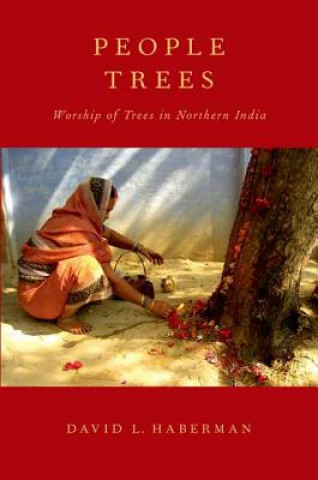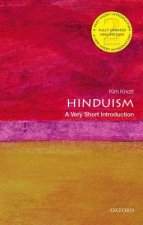
Kód: 04536786
People Trees
Autor David L. Haberman
This is a book about religious conceptions of trees within the cultural world of tree worship at the tree shrines of northern India. Sacred trees have been worshipped for millennia in India and today tree worship continues there a ... celý popis
- Jazyk:
 Angličtina
Angličtina - Väzba: Pevná
- Počet strán: 256
Nakladateľ: OUP USA, 2013
- Viac informácií o knihe

Mohlo by sa vám tiež páčiť
-

Zom-B Chronicles
11.33 € -

Dog Ate My Resume
15.21 €
Darčekový poukaz: Radosť zaručená
- Darujte poukaz v ľubovoľnej hodnote, a my sa postaráme o zvyšok.
- Poukaz sa vzťahuje na všetky produkty v našej ponuke.
- Elektronický poukaz si vytlačíte z e-mailu a môžete ho ihneď darovať.
- Platnosť poukazu je 12 mesiacov od dátumu vystavenia.
Viac informácií o knihe People Trees
Nákupom získate 445 bodov
 Anotácia knihy
Anotácia knihy
This is a book about religious conceptions of trees within the cultural world of tree worship at the tree shrines of northern India. Sacred trees have been worshipped for millennia in India and today tree worship continues there among all segments of society. In the past, tree worship was regarded by many Western anthropologists and scholars of religion as a prime example of childish animism or decadent "popular religion." More recently this aspect of world religious cultures is almost completely ignored in the theoretical concerns of the day. David Haberman hopes to demonstrate that by seriously investigating the world of Indian tree worship, we can learn much about not only this prominent feature of the landscape of South Asian religion, but also something about the cultural construction of nature as well as religion overall. The title People Trees relates to the content of this book in at least six ways. First, although other sacred trees are examined, the pipal-arguably the most sacred tree in India-receives the greatest attention in this study. The Hindi word "pipal" is pronounced similarly to the English word "people." Second, the "personhood" of trees is a commonly accepted notion in India. Haberman was often told: "This tree is a person just like you and me." Third, this is not a study of isolated trees in some remote wilderness area, but rather a study of trees in densely populated urban environments. This is a study of trees who live with people and people who live with trees. Fourth, the trees examined in this book have been planted and nurtured by people for many centuries. They seem to have benefited from human cultivation and flourished in environments managed by humans. Fifth, the book involves an examination of the human experience of trees, of the relationship between people and trees. Haberman is interested in people's sense of trees. And finally, the trees located in the neighborhood tree shrines of northern India are not controlled by a professional or elite class of priests. Common people have direct access to them and are free to worship them in their own way. They are part of the people's religion. Haberman hopes that this book will help readers expand their sense of the possible relationships that exist between humans and trees. By broadening our understanding of this relationship, he says, we may begin to think differently of the value of trees and the impact of deforestation and other human threats to trees.
 Parametre knihy
Parametre knihy
Zaradenie knihy Knihy po anglicky Humanities Religion & beliefs Hinduism
179.65 €
- Celý názov: People Trees
- Autor: David L. Haberman
- Jazyk:
 Angličtina
Angličtina - Väzba: Pevná
- Počet strán: 256
- EAN: 9780199929177
- ISBN: 0199929173
- ID: 04536786
- Nakladateľ: OUP USA
- Hmotnosť: 564 g
- Rozmery: 237 × 161 × 18 mm
- Dátum vydania: 25. April 2013
Obľúbené z iného súdka
-

How You Can Talk with God
6.83 € -

Holy Science
16.03 € -1 % -

Journey to Self-Realization
15.51 € -19 % -

Holy Science
7.04 € -

Bhagavad Gita
11.94 € -17 % -

Kundalini
17.46 € -18 % -

Light on the Yoga Sutras of Patanjali
20.83 € -23 % -

Yoga of Power
17.56 € -3 % -

Metaphysical Meditations
8.98 € -

Mantra Yoga and the Primal Sound
13.17 € -18 % -

Yoga Sutras of Patanjali - Sacred Texts
14.49 € -21 % -

Gods and Goddesses Deck
16.94 € -7 % -

Tantra
16.23 € -13 % -

Four Desires
18.68 € -9 % -

Tree of Yoga
18.27 € -5 % -

Shiva
10.82 € -3 % -

Invoking Lakshmi
42.48 € -

Tantra Illuminated
33.19 € -18 % -

Mahabharata
17.86 € -16 % -

Teachings of Ramana Maharshi
14.90 € -13 % -

Kali
19.50 € -19 % -

Spiritual Teaching of Ramana Maharshi
16.33 € -19 % -

Living Fearlessly
9.18 € -

Ramayana
17.76 € -20 % -

Sri Aurobindo or the Adventure of Consciousness
18.99 € -2 % -

Life Divine - U.S. Edition
28.79 € -7 % -

Original Gospel of Ramakrishna
23.89 € -1 % -

Bhagavad Gita
27.26 € -

Upanishads
7.24 € -12 % -

Twenty Four Aspects of Mother Kali
25.01 € -

Five Dharma Types
17.15 € -19 % -

Gods, Sages and Kings
26.75 € -

Yoga-Sutra of Patanjali
11.12 € -28 % -

Prana and Pranayama
21.95 € -14 % -

Uddhava Gita
13.88 € -19 % -

Avadhuta Gita
4.48 € -5 % -

Rig Veda
33.19 € -

Bhagavad Gita
19.40 € -16 % -

Tantric Kali
13.17 € -18 % -

Paths to God
12.45 € -19 % -

Yugas
23.89 € -

Hindu Myths
12.25 € -23 % -

Introduction to the Study of the Hindu Doctrines
21.85 € -

Bhagavad Gita
14.70 € -19 % -

Introducing Hinduism
10.10 € -22 % -

Hinduism: A Very Short Introduction
10.10 € -22 % -

Conversations with Yogananda
33.08 € -

Faith is My Armor
15.41 € -

Ramana Maharshi
22.66 € -1 %
Osobný odber Bratislava a 2642 dalších
Copyright ©2008-24 najlacnejsie-knihy.sk Všetky práva vyhradenéSúkromieCookies



 21 miliónov titulov
21 miliónov titulov Vrátenie do mesiaca
Vrátenie do mesiaca 02/210 210 99 (8-15.30h)
02/210 210 99 (8-15.30h)